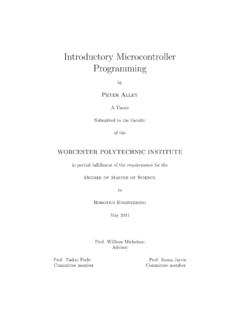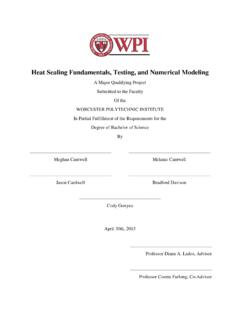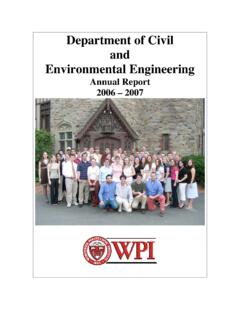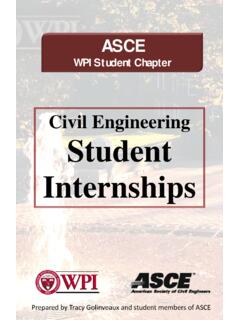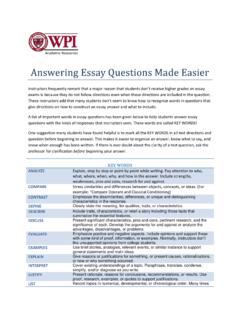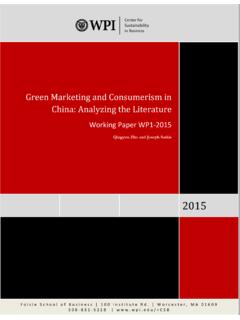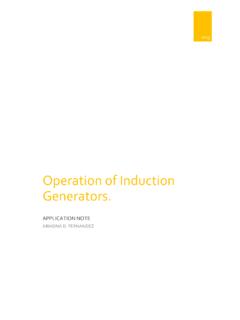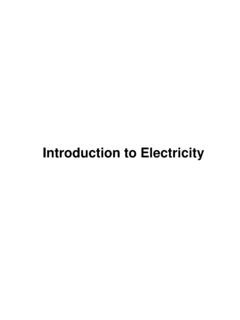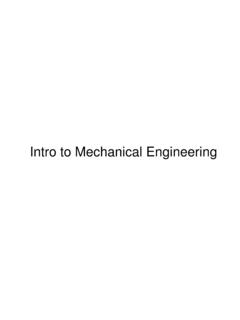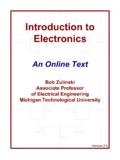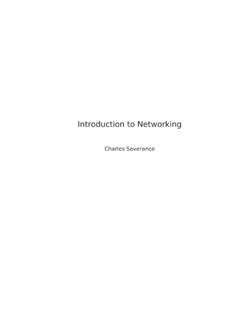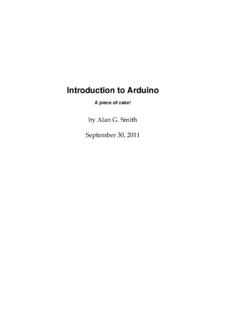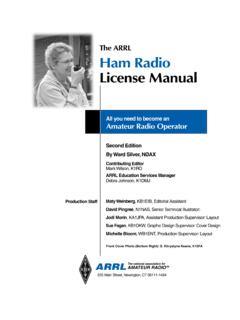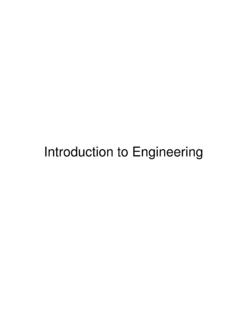Transcription of Vertical Axis Wind Turbine Evaluation and Design
1 I Project # DJO-1235 PPM-1235 Vertical Axis Wind Turbine Evaluation and Design A Major Qualifying Project Report Submitted to the Faculty of the WORCESTER POLYTECHNIC INSTITUTE In partial fulfillment of the requirements for the Degree of Bachelor of Science. Submitted By: _____ Lucas Deisadze _____ Drew Digeser _____ Christopher Dunn _____ Dillon Shoikat Date: April 25th, 2013 _____ Professor Paul Mathisen (CE), Project Advisor _____ Professor David Olinger (ME), Project Advisor ii Certain materials are included under the fair use exemption of the Copyright Law and have been prepared according to the fair use guidelines and are restricted from further use.
2 Iii Abstract This project studied the potential for installing roof-mounted Vertical axis wind Turbine (VAWT) systems on house roofs. The project designed several types of VAWT blades with the goal of maximizing the efficiency of a shrouded Turbine . The project also used a wind simulation software program, WASP, to analyze existing wind data measured on the roofs of various WPI buildings. Scale-model tests were performed in the WPI closed-circuit wind tunnel. An RPM meter and a 12 volt step generator were used to measure Turbine rotation speeds and power output at different wind speeds. The project also studied roof mounting systems for turbines that are meant to dissipate vibrations to the roof structure.
3 Turbine vibrations were measured during the wind tunnel tests and in impact tests on a scale-model house. Recommendations were made for future designs of roof-mounted VAWTs. iv Capstone Design Experience ABET requirement To fulfill the requirements for a Major Qualifying Project (MQP), this project must meet the requirements for a capstone Design experience. The Accreditation Board for Engineering and Technology (ABET) defines the capstone Design experience as an experience based on the knowledge and skills acquired in earlier course work and incorporating engineering standards and realistic constraints that include most of the following considerations: economic; environmental; sustainability; manufacturability; ethical; health and safety; social; and political.
4 (Cryer, 2011) The Design components for this project include the following attributes which satisfy the ABET requirements for capstone Design : Environmental: Environmental concerns have been an important issue in the engineering field. Projects have been taking consideration of environmental impacts as a result of their products. Wind turbines are a form of renewable energy that will help the environment by not producing emissions while creating electricity . As an end result less fossil fuel would be required in order to provide electricity for a house. Sustainability: The project outcome will produce a commodity that will be able to help the environment and make society more self-sustainable.
5 This is accomplished by making society more independent from using fossil fuels. This has been a very big topic as of recent and many different movements happening in America and around the world are focused on using our renewable energy, such as wind. This project is helping the succession of this idea and broadening the capability of turbines to reduce carbon footprints. Manufacturability and Economic: With a simpler Design of these turbines and easier assembly, it will make it possible for local hardware stores to sell these products. Along with simpler v Design this will also decrease manufacturing cost and make it more economical for families to buy.
6 Health and Safety: This project considers health and safety concerns by addressing roof mounting systems. The hope is to Design a mounting system that will not cause structural damage to residential roofs. A mount that is able to diminish vibrations before entering roof trusses will help protect trusses longevity and decrease chance of failure. vi Acknowledgements The VAWT group would like to thank: Professor David Olinger and Paul Mathisen For their guidance, leadership, and dedication to our project from the beginning to the end Professor James O Shaughnessy For originally organizing this project and allowing us to contribute into furthering research on Vertical axis wind turbines Francis X.
7 Reilly, Sr. For introducing us to the idea of using enclosures for Vertical axis wind turbines Peter Hefti For his help and guidance with using lab equipment that was vital in completing the project Don Pellegrino For assisting us with various wind speed instruments as well as repairing damaged equipment The Staff of the WPI Machine Shops, esp. Christopher DeStefano For assisting our group in machining brackets for our mounting system vii Authorship Task Work Done Report Writing For Task Literature Review Drew Digeser, Chris Dunn Drew Digeser, Chris Dunn Component Design Drew Digeser, Chris Dunn Drew Digeser, Chris Dunn Component Manufacturing Drew Digeser, Chris Dunn, Lucas Desidaze Drew Digeser, Chris Dunn Wind Tunnel Testing Drew Digeser, Chris Dunn, Lucas Desidaze Chris Dunn Vibration Testing Drew Digeser, Chris Dunn Drew Digeser WASP Software Dillon Sarkar Dillon Sarkar Suggestions Drew Digeser, Chris Dunn Drew Digeser.
8 Chris Dunn viii Table of Contents Introduction .. 1 2 Background .. 4 Wind intro .. 4 Power Density .. 5 Wind Speed .. 8 Power Coefficient .. 9 Tip Speed Ratio .. 10 Wind Turbine Classification .. 11 HAWT .. 11 VAWT .. 12 The Effects of Shrouds on Vertical Axis Wind Turbines (VAWT) .. 14 Shrouded Wind Turbines .. 16 Savonius VAWT .. 17 Home Turbines .. 18 Background to WASP .. 19 Mounting system .. 21 Noise and Vibrations .. 22 3. Methodology .. 24 Background Research .. 24 Old Projects .. 25 Additional Research .. 25 Design Turbine blade designs to 26 Adjustable angle S1223 airfoil Design .
9 26 Design of split Savonius Turbine .. 28 Scale Model roof structure .. 30 Scale Model 31 Create experimental set 32 Wind Turbine set-up .. 32 ix Generators .. 35 Data Acquisition .. 36 Power output from the generator .. 37 Perform vibrations testing on Turbine .. 38 Perform vibration testing on the scale model house .. 38 Manufacturing of Turbine blades and 40 Building of model house .. 40 Testing .. 41 Turbine testing .. 42 Vibration testing .. 42 Develop future Design recommendations .. 44 4 Results .. 45 Turbine 45 Use of Funnels .. 45 Air Foil Design .. 47 Turbine Results .. 47 Vibration Data.
10 50 Vibration 56 Wind Atlas Analysis and Application Program Results .. 59 Conclusions and Suggestions .. 65 Turbine Design .. 65 Turbine Shrouds and Enclosures .. 67 Mounting System .. 69 WAsP and Wind Power Potential .. 70 Overview .. 70 References .. 71 1 Introduction With populations increasing exponentially and our natural resources being strained by increases in demand, it is more important than ever to invest in renewable energy. Our consumption of fossil fuels as energy has been traced to be a leading cause in environmental issues. The byproduct of fossil fuel consumption is carbon dioxide, which has been named to be a primary constituent leading to Global Warming.
